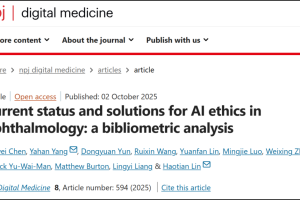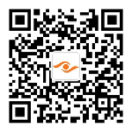
On the morning of September 12, 2024, Zhongshan Ophthalmic Center (ZOC) of Sun Yat-sen University held a press conference at its Zhujiang New Town campus to announce a groundbreaking study. A research team led by Professor Lingyi Liang / Professor Yizhi Liu from ZOC and Professor Zuguo Liu from the Eye Institute of Xiamen University, published an original clinical research paper in the prestigious international medical journal The BMJ (The British Medical Journal). The study confirmed the therapeutic effects of "laughter exercise" for dry eye disease. The press conference was chaired by Professor Haotian Lin, President of ZOC. Professor Lingyi Liang, the project leader and final corresponding author of the paper, presented the findings.
Group photo of invited leaders, guests, and the research team at the press conference
Research Background
Dry eye disease, one of the most prevalent eye conditions, causes symptoms such as dryness, grittiness, and a foreign body sensation in the eyes, significantly impairing patients' vision and quality of life. In recent years, due to factors such as the increased use of digital devices, late-night lifestyle, and prolonged exposure to air-conditioned environments, the incidence of dry eye disease has surged year by year, becoming a global health concern. Artificial tears are the current first-line treatment. However, long-term reliance on artificial tears can be costly for patients and the disposal of vast numbers of plastic eye drop bottles burdens the environment.
Many studies link the occurrence and development of dry eye to lifestyle factors and psychological states like depression and anxiety. The adage "Laughter is the best medicine" finds support in evidence showing "laughter therapy" can alleviate depression, anxiety, stress, and chronic pain while boosting immune function. Over the past five decades, it has been recognized as an effective complementary approach for chronic conditions including mental health disorders, cancer, and diabetes.
Could "laughter therapy" also benefit dry eye, an emotion-linked chronic disease? If so, how does its efficacy compare to the most common artificial tear (0.1% sodium hyaluronate)?
Study Publication and Significance
The research paper, titled "Effect of laughter exercise versus 0.1% sodium hyaluronic acid on ocular surface discomfort in dry eye disease: non-inferiority randomised controlled trial”, was recently published in The BMJ (a top-tier journal in the Chinese Academy of Sciences ranking). The study confirmed the therapeutic effects of "laughter exercise" on dry eye disease. This paper marks the first original clinical research finding from ZOC published in The BMJ with ZOC as both the first author and corresponding author institution. It is also one of the very few clinical studies from China’s ophthalmology field published in one of the world's four leading clinical medical journals (New England Journal of Medicine, The Lancet, JAMA, and The BMJ).
Study Design and Results
This prospective, non-inferiority, randomised controlled clinical trial enrolled 299 participants with symptomatic dry eye disease who showed no moderate or severe corneal fluorescein staining. The participants were randomly assigned to one of two groups: one received 0.1% sodium hyaluronic acid eye drops for 8 weeks, while the other performed "laughter exercise." A "laughing face" mobile app was used to record and track the intervention. The laughter exercise protocol, developed by the research team, involved facial and ocular muscle exercises using vocal phrases such as “Hee hee hee, hah hah hah, cheese cheese cheese, cheek cheek cheek, hah hah hah hah hah hah,” with 30 repetitions per session, lasting at least five minutes.
After 8 weeks, both the laughter exercise group and the artificial tears group showed improvements in symptoms and ocular signs. Notably, the primary outcome measure—the Ocular Surface Disease Index (OSDI), a subjective measure of dry eye disease severity—indicated that laughter exercise was no less effective than 0.1% sodium hyaluronic acid. In some ocular sign improvements, laughter exercise even outperformed the artificial tear treatment. This study provides strong evidence that laughter exercise is a safe, effective, low-cost, and environmentally friendly non-pharmacological treatment for dry eye.
" laughter exercise" Check-in Mobile App
Implications and Future Directions
This study compared changes in dry eye symptoms, ocular signs, and psychological factors (such as anxiety and depression) between the two groups. The results show that laughter exercise is as effective as, and in some cases even more effective than, 0.1% sodium hyaluronic acid in alleviating dry eye symptoms. These findings introduce a novel treatment approach for dry eye disease, bringing new hope to patients who have long relied on eye drops. Moreover, this research opens up new possibilities for studying the underlying mechanisms of dry eye disease and exploring additional non-drug therapies.
The laughter exercise was non-inferior to 0.1% sodium hyaluronic acid in relieving subjective symptoms in patients with dry eye disease with limited corneal staining over eight weeks intervention.
Authorship
Zhongshan Ophthalmic Center (ZOC), State Key Laboratory of Ophthalmology, Sun Yat-sen University, is the primary affiliation for both first and corresponding authors.
- Co-first authors: Jing Li (Attending Physician, ZOC), Yinglin Liao (PhD candidate), Shiyao Zhang (Master's student).
- Co-corresponding authors: Prof. Lingyi Liang and Prof. Yizhi Liu (ZOC), Prof. Zuguo Liu (Eye Institute of Xiamen University).
Link to the research paper:
https://www.bmj.com/content/386/bmj-2024-080474











